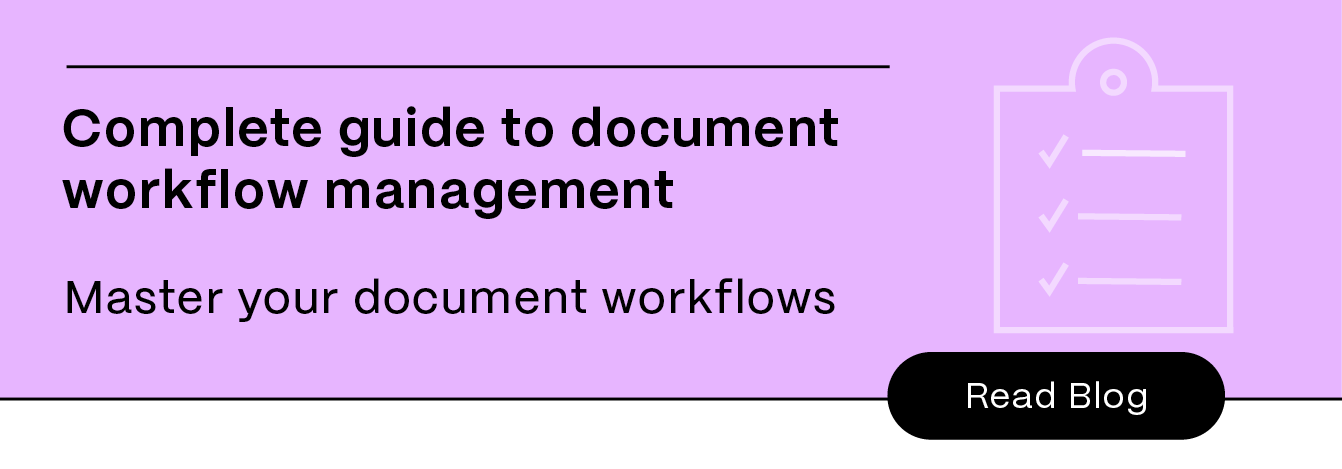
Blog
Mastering approval workflows: how to track and automate document approvals

There are many tasks within a business that require approval, from finalizing invoices and confirming new strategies to scheduling employee time off. That’s why standardized approval processes are so important.
Workflows help managers stay in-the-loop so they can confirm decisions and make sure staff follow company guidelines when submitting requests. Despite their helpfulness, approval processes can be tedious, requiring a lot of outreach and follow-up. It takes the right technology and strategies to simplify your approach and prevent reviews from slowing things down.
Keep reading to learn how to effectively track and automate your document approval process.
Key takeaways
- Document approval workflows ensure staff follow the correct steps for getting files approved.
- A workflow approval process is any series of tasks needed to approve business decisions.
- Elements of a standard workflow include roles, permissions, deadlines, and status tracking.
- There are five commonly used steps for approval workflows.
- Time savings, fewer errors, and reduced costs are all benefits of effective workflows.
- Improve workflow progress and eliminate bottlenecks with software to automate approval tracking.
- Follow the best practices listed in this guide to improve approval workflow efficacy.

What are document approval workflows?
A document approval workflow is the set of steps required to ensure files like contracts and legal agreements are approved by appropriate stakeholders.
For businesses that manage important documents on a regular basis, effective approval workflows are key to overall efficiency. Because these workflows save staff time and keep sensitive data safe, clients and vendors are more likely to feel satisfied with businesses using them. The result? An uptick in referrals and positive reviews.
What is a workflow approval process?
A workflow approval process is defined as any series of tasks that are necessary for approving business actions and decisions. Document workflow approvals are one example.
What elements are required for a workflow approval process?
Task descriptions
Explains what needs to be done to achieve a specific goal. Creating documents for approval, sending documents to stakeholders, and setting up a meeting to discuss changes are all tasks that might be incorporated into an approval workflow.
Roles and permissions
Assigns specific employees to actions. An approval workflow will clearly state who is responsible for carrying out activities such as finalizing contracts or submitting proposals. Depending on who is required to sign off, workflows may also specify who can view and edit files. Always set controls so that only required parties have access to documents, limiting entry points for cyberattacks.
Deadlines
Establishes a timeline for completing each step within the workflow. Setting deadlines for each approvals workflow task helps keep teams on track.
Notifications
Alerts involved parties of status updates. For example, if a project is running behind, the team responsible could receive a notification reminding them of approaching deadlines. This calls the issue to everyone’s attention so they can get organized and complete work on time.
Status tracking
Outlines how progress must be logged for transparency. Depending on the company’s needs and priorities, requiring staff to record each step of a workflow as it occurs helps maintain vigilance throughout the approval process.
What are the steps of the approval process?
While processes vary based on what items are being approved, here are some steps commonly used for approval workflows:
Step 1: Determine roles
Define which employees are responsible for seeking approvals and who is qualified to grant them.
Step 2: Collect information and documents
Have staff assemble files or actions that need to be reviewed.
Step 3: Meet approval conditions
Detail what is required for documents and decisions to be made official. The appropriate staff members will work to confirm all pre-established guidelines for approval are met.
Step 4: Collaborate with stakeholders
Engage stakeholders to address any nuances or issues standing in the way of completing the workflow. Staff may need to go through multiple rounds of feedback to resolve concerns.
Step 5: Gain approval and update status logs
Once items are final, employees will update logs according to company policy. This creates a record of important business developments to improve transparency.
What are the benefits of approval workflows?
Because approvals are required across many different departments, efficient review processes have a wide-ranging impact for business. Benefits of streamlined, straightforward approval workflows include:
- Time savings: Speed up decision making with clear processes that don’t require as much back-and-forth communication. This gives employees more time to focus on high-priority work.
- Fewer errors: Set clear guidelines for each workflow step to minimize inconsistencies and mistakes when.
- Reduced costs: Reduce waste and save money by automating redundant tasks.
- Effective internal communication: Enhance visibility for stakeholders and ensure all staff are aligned on best practices for important documents and tasks.
How to track approvals through automation
Software that can automate approval tracking provides transparency into workflow progress and bottlenecks, supporting smart decision making that moves processes along. Here are a few steps for tracking reviews with automation tools:
- Establish and automate a centralized dashboard for approval requests. View the status of every request in one place to quickly understand where each item stands and what needs to be done next. To help staff focus on the most pressing work, use automation to organize dashboards in a way that calls attention to priority items. For example, if a project becomes delayed and tasks must be addressed immediately, platforms can automatically highlight those items or move them to the top of a queue.
- Prepare notifications and reminders. Improve tracking by instantly alerting employees to changes as they occur with automatic notifications.
- Automatic status update logging. Eliminate manual record-keeping by automatically logging all developments and status changes throughout the approval process.
Aside from improving visibility into major developments, approval process automation also maximizes efficiency. In the next section, we’ll explore best practices for using automation along with ways to enhance approvals across documents and workflows.
Related read: Best workflow automation for small businesses
Best practices to streamline the workflow approval process
Follow these tips to improve the effectiveness of approval workflows:
Map ideal workflows
Start by mapping out current approval workflows and see if there are any unnecessary steps that can be removed. Eliminating these enables teams to complete approvals as quickly as possible.
Provide straightforward guidelines
Make sure approvers and reviewers understand their roles and responsibilities. Include guidance within workflows detailing how each party must carry out assigned tasks in accordance with company policy.
Implement automation to reduce manual tasks
Accelerate authorization processes by letting automation take over repetitive steps. Filling out forms and requesting signatures from multiple people are time-consuming, error-prone tasks. Instead of relying on humans to complete this work, use an automated approval process to improve accuracy and give employees more time for strategic initiatives.
Related read: Transform your business with AI workflow automation
Centralize approval documentation
Having a single platform for all required approval documents improves organization and reduces friction. It’s much easier to log into a single system and pull up needed files than it is to search through multiple folders and locations manually.
Build a template library
Simplify the process of creating approval documents by using a database of commonly used file templates. This way, staff don’t need to build contracts and request forms from scratch. Businesses can also speed up workflows by using automation to fill in outlines with relevant details.
Enable mobile accessibility
Enable document signing on mobile devices to accommodate approvers on the go. 91% of Americans own smartphones, and many people are accustomed to using them for work. Giving employees the option to complete approval processes on personal devices provides flexibility and support to get things done faster.
Prioritize security
Safeguard sensitive documents with robust data-protection features. Workflow tools should prevent any security gaps that leave opportunities for cybercriminals to steal data. To lower the risk of breaches, look for solutions with the following capabilities:
- Strong encryption: Provide the highest level of file security for approval workflows by using 256-bit encryption.
- Access controls: Reduce opportunities for hackers by limiting file access to only necessary parties.
- Multi-factor authentication: Ensure no one can get into accounts with stolen credentials by requiring multiple forms of authentication on different devices.
- Audit trails: Conveniently identify and investigate instances of tampering within approval workflows.
Leverage data insights
Platforms that collect and analyze data on processes help identify issues standing in the way of efficiency. With insight into where bottlenecks commonly occur, teams can take informed actions to improve workflows.
Make regular optimizations
To maintain approval workflows that are streamlined and efficient, regularly assess processes and make adjustments as needed.

Approval workflow tools: do more with less
Approvals are necessary to make sure that critical decisions and documents are reviewed by the right stakeholders at the right time. While these workflows may contain many complex steps, they don’t have to be a burden.
By following the advice outlined in this guide, businesses can develop better authorization procedures that support smooth operations. For approvals that are as seamless as possible, take advantage of automation tools that empower teams to get more done during the work day.
Related Resources

Blog